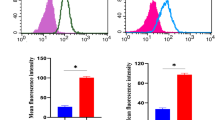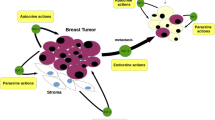Abstract
Background
IGF1 is a key regulator of tissue growth and development and has been implicated in the initiation and progression of various cancers, including breast cancer. Through IGF1 mRNA splicing different precursor pro-peptides, i.e., the IGF1Ea, IGF1Eb and IGF1Ec pro-forms, are formed whose biological roles in the pathogenesis of breast cancer have not been established yet. The objective of this study was to assess the biological activity of the IGF1 pro-forms in human breast cancer-derived cells.
Methods
The different IGF1 pro-forms were generated through transient transfection of HEK293 cells with the respective vector constructs. The resulting conditioned media were applied in vitro to MCF7, T47D and ZR751 breast cancer-derived cell cultures. The recombinant human IGF1 pro-forms were also tested for their binding affinity to an anti-IGF1 specific antibody by immunoprecipitation. To determine whether the IGF1 pro-forms induce cell proliferation, mature IGF1 was neutralised in HEK293-derived conditioned media.
Results
We found that the IGF1 pro-forms were the only forms that were produced intra-cellularly, whereas both mature IGF1 and the IGF1 pro-forms were detected extra-cellularly. We also found that E peptides can impair the IGF1 pro-form binding affinity for the anti-IGF1 antibody and, thus, hamper an accurate measurement of the IGF1 pro-forms. Additionally, we found that the IGF1 antibody can completely inhibit IGF1-induced breast cancer cell proliferation and IGF1 receptor (IGF1R) phosphorylation, wheras the same antibody was found to only partially inhibit the biological activity of the pro-forms. Moreover, we found that the IGF1 pro-form activities can completely be inhibited by neutralising the IGF1R. Finally, we compared the bioactivity of the IGF1 pro-forms to that of mature IGF1, and found that the IGF1 pro-forms were less capable of phosphorylating the IGF1R in the breast cancer-derived cells tested.
Conclusions
Our data indicate that IGF1 pro-forms can induce breast cancer cell proliferation via the IGF1R, independent from the mature IGF1 form. These results underline the importance of an accurate assessment of the presence of IGF1 pro-forms within the breast cancer microenvironment.







Similar content being viewed by others
References
S. J. Weroha, P. Haluska, IGF system in cancer. Endocrinol. Metab. Clin. N. Am. 41(335–350) (2012)
M. V. Karamouzis, A. G. Papavassiliou, Targeting insulin-like growth factor in breast cancer therapeutics. Crit. Rev. Oncol. Hematol. 84, 8–17 (2012)
E. Hormones, B. C. C. Group, Insulin-like growth factor 1 (IGF1), IGF binding protein 3 (IGFBP3), and breast cancer risk: pooled individual data analysis of 17 prospective studies. Lancet Oncol. 11, 530–542 (2010)
T. O. Nielsen, H. N. Andrews, M. Cheang, J. E. Kucab, F. D. Hsu, J. Ragaz, C. B. Gilks, N. Makretsov, C. D. Bajdik, C. Brookes, L. M. Neckers, V. Evdokimova, D. G. Huntsman, S. E. Dunn, Expression of the insulin-like growth factor I receptor and urokinase plasminogen activator in breast cancer is associated with poor survival: potential for intervention with 17-allylamino geldanamycin. Cancer Res. 64, 286–291 (2004)
E. R. Barton, The ABCs of IGF-I isoforms: impact on muscle hypertrophy and implications for repair. Appl. Physiol. Nutr. Metab. 31, 791–797 (2006)
A. Philippou, M. Maridaki, S. Pneumaticos, M. Koutsilieris, The complexity of the IGF1 gene splicing, posttranslational modification and bioactivity. Mol. Med. 7, 202–214 (2014)
B. K. Brisson, E. R. Barton, New modulators for IGF-I activity within IGF-I processing products. Front. Endocrinol. 27, 42 (2013)
D. R. Powell, P. D. Lee, D. Chang, F. Liu, R. L. Hintz, Antiserum developed for the E peptide region of insulin-like growth factor IA prohormone recognizes a serum protein by both immunoblot and radioimmunoassay. J. Clin. Endocrinol. Metab. 65, 868–875 (1987)
C. A. Conover, B. K. Baker, L. K. Bale, J. T. Clarkson, F. Liu, R. L. Hintz, Human hepatoma cells synthesize and secrete insulin-like growth factor Ia prohormone under growth hormone control. Regul. Pept. 48, 1–8 (1993)
C. A. Conover, B. K. Baker, R. L. Hintz, Cultured human fibroblasts secrete insulin-like growth factor IA prohormone. J. Clin. Endocrinol. Metab. 69, 25–30 (1989)
H. E. Wilson, M. Westwood, A. White, P. E. Clayton, Monoclonal antibodies to the carboxy-terminal Ea sequence of pro-insulin-like growth factor-IA (proIGF-IA) recognize proIGF-IA secreted by IM9 B-lymphocytes. Growth Hormon. IGF Res. 11, 10–17 (2001)
E. R. Barton, S. Park, J. K. James, C. A. Makarewich, A. Philippou, D. Eletto, B. Brisson, O. Ostrovsky, Z. Li, Y. Argon, Deletion of muscle GRP94 impairs both muscle and body growth by inhibiting local IGF production. FASEB J. 26, 3691–3702 (2012)
J. Durzynska, A. Philippou, B. K. Brisson, M. Nguyen-McCarty, E. R. Barton, The pro-forms of insulin-like growth factor I (IGF-I) are predominant in skeletal muscle and alter IGF-I receptor activation. Endocrinol. 154, 1215–1224 (2013)
A. Philippou, E. Papageorgiou, G. Bogdanis, A. Halapas, A. Sourla, M. Maridaki, N. Pissimissis, M. Koutsilieris, Expression of IGF-1 isoforms after exercise-induced muscle damage in humans: characterization of the MGF E peptide actions in vitro. In Vivo 23, 567–575 (2009)
B. R. McKay, C. E. O’Reilly, S. M. Phillips, M. A. Tarnopolsky, G. Parise, Co-expression of IGF-1 family members with myogenic regulatory factors following acute damaging muscle-lengthening contractions in humans. J. Physiol. 586, 5549–5560 (2008)
D. S. Milingos, A. Philippou, A. Armakolas, E. Papageorgiou, A. Sourla, A. Protopapas, A. Liapi, A. Antsaklis, M. Mastrominas, M. Koutsilieris, Insulinlike growth factor-1Ec (MGF) expression in eutopic and ectopic endometrium endometrium: characterization of the MGF E-peptide actions in vitro. Mol. Med. 17, 21–28 (2010)
A. Armakolas, A. Philippou, Z. Panteleakou, A. Nezos, A. Sourla, C. Petraki, M. Koutsilieris, Preferential expression of IGF-1Ec (MGF) transcript in cancerous tissues of human prostate: evidence for a novel and autonomous growth factor activity of MGF E peptide in human prostate cancer cells. Prostate 70, 1233–1242 (2010)
M. M. Koczorowska, A. Kwasniewska, A. Gozdzicka-Jozefiak, IGF1 mRNA isoform expression in the cervix of HPV-positive women with pre-cancerous and cancer lesions. Exp. Ther. Med. 2, 149–156 (2011)
A. Kasprzak, W. Szaflarski, J. Szmeja, M. Andrzejewska, W. Przybyszewska, E. Kaczmarek, M. Koczorowska, T. Kościński, M. Zabel, M. Drews, Differential expression of IGF-1 mRNA isoforms in colorectal carcinoma and normal colon tissue. Int. J. Oncol. 42, 305–316 (2012)
Y. H. Kuo, T. T. Chen, Novel activities of pro-IGF-I E peptides: regulation of morphological differentiation and anchorage-independent growth in human neuroblastoma cells. Exp. Cell Res. 280, 75–89 (2002)
B. Poudel, D. Bilbao, P. Sarathchandra, R. Germack, N. Rosenthal, M. P. Santini, Increased cardiogenesis in P19-GFP teratocarcinoma cells expressing the propeptide IGF-1Ea. Biochem. Biophys. Res. Commun. 416, 293–299 (2011)
T. Norat, L. Dossus, S. Rinaldi, K. Overvad, H. Grønbaek, A. Tjønneland, A. Olsen, F. Clavel-Chapelon, M. C. Boutron-Ruault, H. Boeing, P. H. Lahmann, J. Linseisen, G. Nagel, A. Trichopoulou, D. Trichopoulos, V. Kalapothaki, S. Sieri, D. Palli, S. Panico, R. Tumino, C. Sacerdote, H. B. Bueno-de-Mesquita, P. H. Peeters, C. H. van Gils, A. Agudo, P. Amiano, E. Ardanoz, C. Martinez, R. Quirós, M. J. Tormo, S. Bingham, T. J. Key, N. E. Allen, P. Ferrari, N. Slimani, E. Riboli, R. Kaaks, Diet, serum insulin-like growth factor-I and IGF-binding protein-3 in European women. Eur. J. Clin. Nutr. 61, 91–98 (2007)
L. Galluzzi, M. De Santi, R. Crinelli, C. De Marco, N. Zaffaroni, A. Duranti, G. Brandi, M. Magnani, Induction of endoplasmic reticulum stress response by the indole-3-carbinol cyclic tetrameric derivative CTet in human breast cancer cell lines. PLoS One 7, e43249 (2012)
M. De Santi, L. Galluzzi, S. Lucarini, M. F. Paoletti, A. Fraternale, A. Duranti, C. De Marco, M. Fanelli, N. Zaffaroni, G. Brandi, M. Magnani, The indole-3-carbinol cyclic tetrameric derivative CTet inhibits cell proliferation via overexpression of p21/CDKN1A in both estrogen receptor-positive and triple negative breast cancer cell lines. Breast Cancer Res. 13, R33 (2011)
S. J. Duguay, W. M. Milewski, B. D. Young, K. Nakayama, D. F. Steiner, Processing of wild-type and mutant proinsulin-like growth factor-IA by subtilisin-related proprotein convertases. J. Biol. Chem. 272, 6663–6670 (1997)
M. S. Hede, E. Salimova, A. Piszczek, E. Perlas, N. Winn, T. Nastasi, N. Rosenthal, E-peptides control bioavailability of IGF-1. PLoS One 7, e51152 (2012)
E. R. Barton, Viral expression of insulin like growth factor-I isoforms promotes different responses in skeletal muscle. J. Appl. Physiol. 100, 1778–1784 (2006)
M. Vinciguerra, A. Musarò, N. Rosenthal, Regulation of muscle atrophy in aging and disease. Adv. Exp. Med. Biol. 694, 211–233 (2010)
M. P. Santini, L. Tsao, L. Monassier, C. Theodoropoulos, J. Carter, E. Lara-Pezzi, E. Slonimsky, E. Salimova, P. Delafontaine, Y. H. Song, M. Bergmann, C. Freund, K. Suzuki, N. Rosenthal, Enhancing repair of the mammalian heart. Circ. Res. 100, 1732–1740 (2007)
M. P. Santini, J. Lexow, G. Borsellino, E. Slonimski, E. Zarrinpashneh, T. Poggioli, N. Rosenthal, IGF-1Ea induces vessel formation after injury and mediates bone marrow and heart cross-talk through the expression of specific cytokines. Biochem. Biophys. Res. Commun. 410, 201–207 (2011)
Y. Feng, Z. Zhu, X. Xiao, V. Choudhry, J. C. Barrett, D. S. Dimitrov, Novel human monoclonal antibodies to insulin-like growth factor (IGF)-II that potently inhibit the IGF receptor type I signal transduction function. Mol. Cancer Ther. 5, 114–120 (2006)
Acknowledgments
The authors would like to thank Dr. Joanne Tonkin and Dr. Tommaso Nastasi for kindly providing the IGF1 pro-form specific constructs for the cell transfections.
Author information
Authors and Affiliations
Corresponding author
Ethics declarations
Funding
This study was supported by the RF-2009-1,532,789 Ministry of Health Project-Italy.
Conflict of interest
The authors declare that there is no conflict of interest that could be perceived as prejudicing the impartiality of the research reported.
Electronic supplementary material
Rights and permissions
About this article
Cite this article
De Santi, M., Annibalini, G., Barbieri, E. et al. Human IGF1 pro-forms induce breast cancer cell proliferation via the IGF1 receptor. Cell Oncol. 39, 149–159 (2016). https://doi.org/10.1007/s13402-015-0263-3
Accepted:
Published:
Issue Date:
DOI: https://doi.org/10.1007/s13402-015-0263-3




